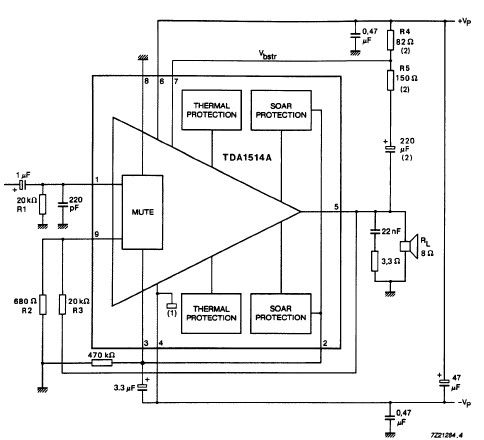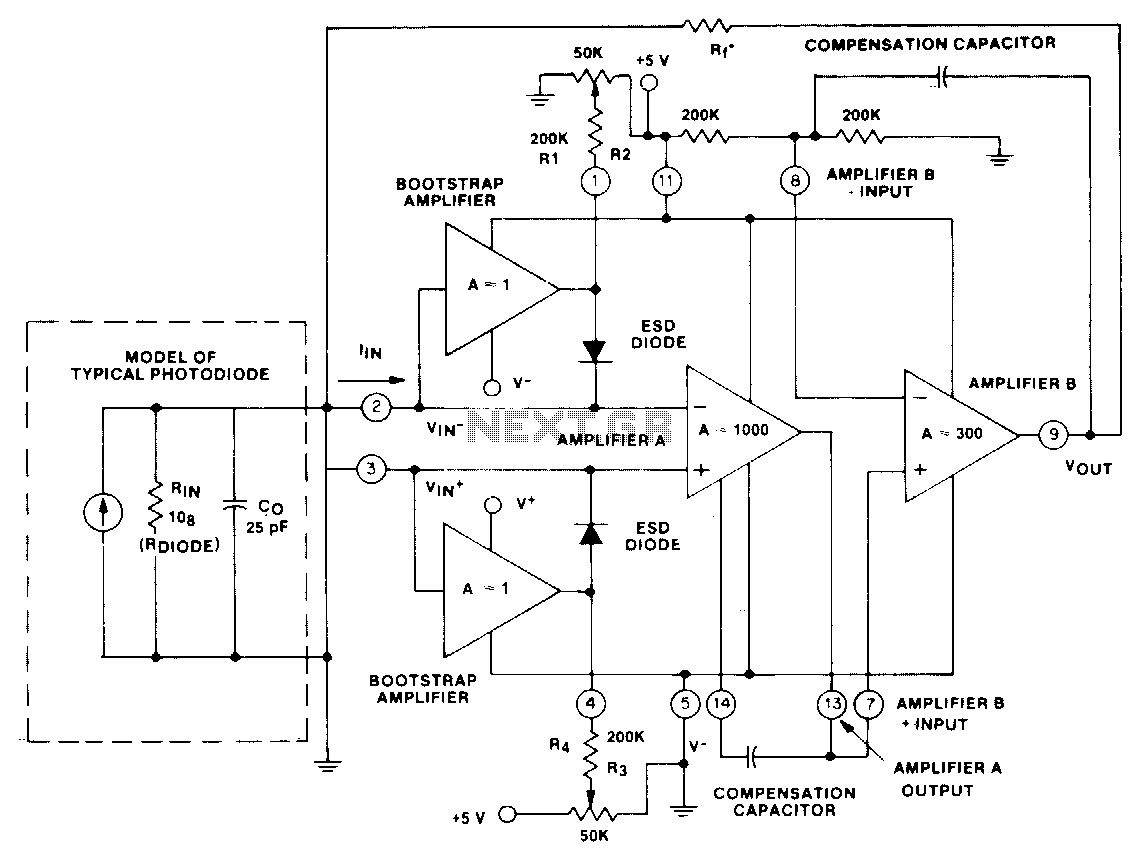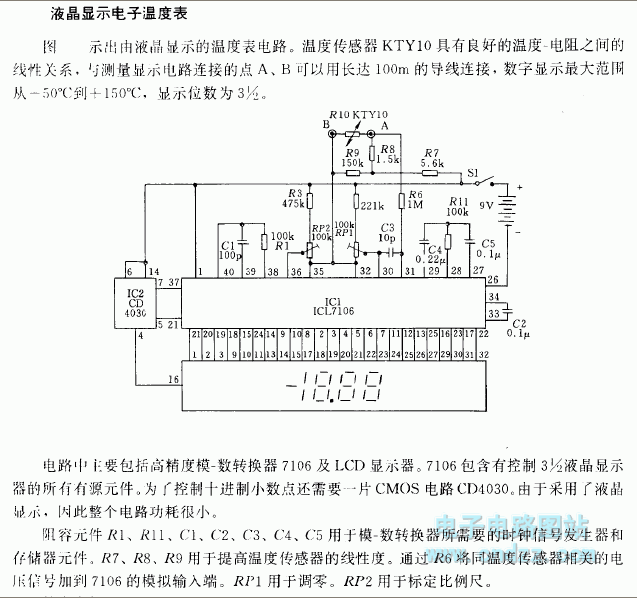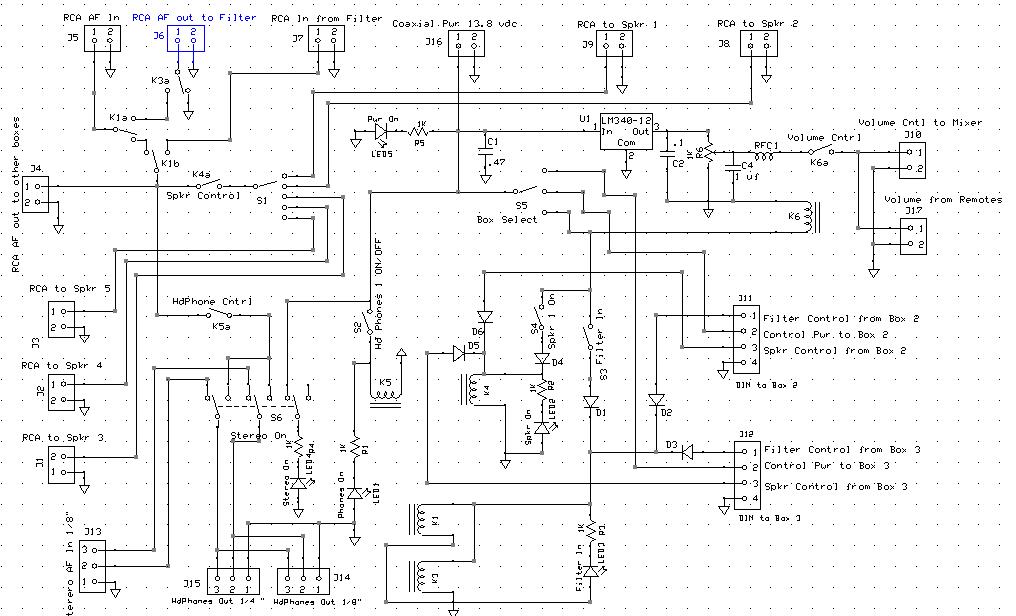
op amp Reducing noise in audio circuit (optical pickup + op amp)

A passive high-pass filter has been added after the output of the operational amplifier (op-amp) to eliminate DC offset, with the op-amp powered by +12V and the negative supply at 0V. A feedback resistor (Rf) of 500K Ohms is utilized, which may be excessive. An LED, functioning as a light source, is positioned adjacent to the photodiode and powered by 5V, sourced from a PC power supply. Both components are connected via a 2-meter long guitar cable (PL). The circuit successfully generates an audio signal when the intensity of light on the photodiode is modulated; however, it suffers from significant noise issues. Two types of noise are noted: electrical noise resembling that of a noisy electric guitar pickup, likely caused by the long cable or its tip collecting ambient electromagnetic interference, and thermal noise amplified during signal generation, attributed to the high gain setting. Enhancing the signal-to-noise ratio at the source is recommended by optimizing environmental conditions, including ambient light levels and the precise positioning of the photodiode.
The described circuit integrates a photodiode and an LED, with the op-amp configured to amplify the current generated by the photodiode in response to light intensity changes. The passive high-pass filter serves to block any DC signals, allowing only AC signals—representative of modulated light intensity—to pass through to the output. This configuration is essential for applications where accurate signal representation is critical, such as audio signal processing.
The choice of a 500K Ohm feedback resistor (Rf) may contribute to excessive gain, potentially leading to increased susceptibility to noise, including thermal noise and electromagnetic interference. The use of a guitar cable as a connection medium introduces additional capacitance and inductance, which can further exacerbate noise issues by acting as an antenna for ambient electromagnetic fields.
To mitigate these noise problems, several strategies can be employed. Shielded cables should be considered to reduce electromagnetic interference, particularly in environments with high levels of noise. Additionally, implementing a differential signaling approach may help to cancel out common-mode noise. The positioning of the photodiode should be optimized to minimize exposure to stray light sources and electromagnetic fields, ensuring that the light source remains consistent and focused. Finally, the circuit can benefit from the inclusion of additional filtering stages or noise reduction techniques, such as low-pass filters or digital signal processing, to further enhance the signal-to-noise ratio.Except that I`ve added a passive high-pass filter after the output of the op-amp, to eliminate DC (since I am using 0V and +12V as my V- and V+, respectively). I use Rf=500K Ohm (is this way too much ). In addition, I have an LED adjacent to the photodiode that serves as a light source. The LED is powered by 5V and the op-amp is powered by 12V, bo th from a PC power supply. The photodiode and LED are connected to the circuit using a 2m long guitar cable ("PL"). The circuit works and produces audio signal when I modulate the intensity of the light shining on the photodiode, but my problem is that the signal is very noisy. I can hear/see two types of noise: Electrical noise similar to a noisy electric guitar pickup. I suspect that it originates in the long cable (or the tip of it, where the photodiode and the LED are conected) collecting ambient electromagnetic noise.
This noise is present all the time, even when no light is shining on the photodiode. Another noise is present only when a signal is generated, i. e only when I modulate the light intensity. I suspect it is a result of amplifying thermal noise, since my gain is very high. Improving the signal to noise ratio at the source, i. e by optimizing the physical conditions (ambient light, precision of the position of the photodiode, etc. ). 🔗 External reference
The described circuit integrates a photodiode and an LED, with the op-amp configured to amplify the current generated by the photodiode in response to light intensity changes. The passive high-pass filter serves to block any DC signals, allowing only AC signals—representative of modulated light intensity—to pass through to the output. This configuration is essential for applications where accurate signal representation is critical, such as audio signal processing.
The choice of a 500K Ohm feedback resistor (Rf) may contribute to excessive gain, potentially leading to increased susceptibility to noise, including thermal noise and electromagnetic interference. The use of a guitar cable as a connection medium introduces additional capacitance and inductance, which can further exacerbate noise issues by acting as an antenna for ambient electromagnetic fields.
To mitigate these noise problems, several strategies can be employed. Shielded cables should be considered to reduce electromagnetic interference, particularly in environments with high levels of noise. Additionally, implementing a differential signaling approach may help to cancel out common-mode noise. The positioning of the photodiode should be optimized to minimize exposure to stray light sources and electromagnetic fields, ensuring that the light source remains consistent and focused. Finally, the circuit can benefit from the inclusion of additional filtering stages or noise reduction techniques, such as low-pass filters or digital signal processing, to further enhance the signal-to-noise ratio.Except that I`ve added a passive high-pass filter after the output of the op-amp, to eliminate DC (since I am using 0V and +12V as my V- and V+, respectively). I use Rf=500K Ohm (is this way too much ). In addition, I have an LED adjacent to the photodiode that serves as a light source. The LED is powered by 5V and the op-amp is powered by 12V, bo th from a PC power supply. The photodiode and LED are connected to the circuit using a 2m long guitar cable ("PL"). The circuit works and produces audio signal when I modulate the intensity of the light shining on the photodiode, but my problem is that the signal is very noisy. I can hear/see two types of noise: Electrical noise similar to a noisy electric guitar pickup. I suspect that it originates in the long cable (or the tip of it, where the photodiode and the LED are conected) collecting ambient electromagnetic noise.
This noise is present all the time, even when no light is shining on the photodiode. Another noise is present only when a signal is generated, i. e only when I modulate the light intensity. I suspect it is a result of amplifying thermal noise, since my gain is very high. Improving the signal to noise ratio at the source, i. e by optimizing the physical conditions (ambient light, precision of the position of the photodiode, etc. ). 🔗 External reference





